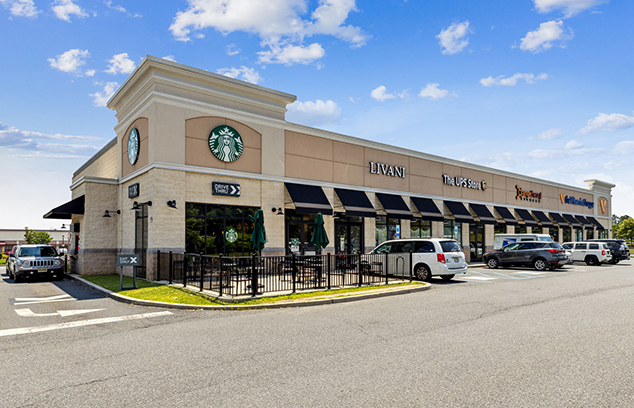Asia Pacific Real Estate Takes Flight in 2025
October 2025
Asia Pacific Real Estate
Takes Flight in 2025
Despite a year rife with uncertainty, real estate in Asia-Pacific markets has demonstrated strong fundamentals in various sectors and emerged as an asset class poised to weather continued volatility. Several factors have contributed to the strength of the APAC markets, specifically the Japan and Hong Kong regions, including sector dynamics, valuations, and inflation expectations.
Japan
Real estate has been one of the year’s top performers in Japan, consistently outpacing the broader Topix despite heightened macro volatility. Several dynamics explain this relative strength.
In January, the Bank of Japan raised its benchmark rate from 25bps to 50bps—its third hike in one year—from a multi-year low of -0.1%. While rate hikes usually weigh on real estate, Japanese real estate has historically outperformed in the month following a hike. The rarity of policy rate moves, combined with the BoJ’s telegraphed and gradual approach, makes the hikes a signal of stability rather than stress, often sparking relief buying. At the same time, yen strength in Q1 along with trade uncertainty hurt Japan’s export-heavy corporates, further tilting capital flows toward domestic defensive sectors like real estate.
Beyond these near-term shifts, real estate fundamentals underpin the sector’s performance. Tokyo’s office market has tightened dramatically: vacancy rates, which peaked in 2023, dropped below the key 5% threshold in late 2024, marking the point at which landlords regain pricing power, and have since fallen under 3%. So far in 2025, this sector has experienced robust leasing demand and rent growth. Though office only represents a very small part of the U.S. REIT index currently, the opposite still holds true for Japan. Developers continue to obtain most of their leasing income from office properties, and in the Japanese REIT universe, over a third of AUM is in the office sector. Hence, the office sector’s fortunes have an outsized impact on the valuations of listed real estate companies in Japan.
Another driver is the gradual mindset shift away from decades of deflation. Inflation has proven stickier than many expected and labor shortages are adding to cost pressures, with decade-high wage settlements in Japan’s Shunto, or spring wage negotiations. This inflation is slowly being realized through rent growth across real estate sectors. We saw it first in the hotel sector, where landlords successfully passed through higher costs post-COVID. Multifamily followed last year, and office is now joining the trend. Even logistics—where supply has been less tight—is seeing more CPI-linked lease structures. Once doubted, real estate in Japan is increasingly proving its value as an inflation hedge.
The final driver is corporate reform. The Tokyo Stock Exchange has pushed companies trading below book value to improve capital efficiency and shareholder returns. Developers, long undervalued and asset-heavy, have been at the forefront of this reform—undertaking asset disposals, boosting buybacks, and unwinding cross-shareholdings. Shareholder payout ratios have risen from 50% to 60% over the last decade, while buybacks in the 2024–25 fiscal year jumped nearly 90% year-on-year. Activist investors are also playing a larger role, accelerating governance improvements and unlocking value. Together, these reforms are creating a virtuous cycle of stronger balance sheets, higher valuations, and more investor engagement.
Reforms are creating a virtuous cycle of stronger balance sheets, higher valuations, and more investor engagement.

Hong Kong
Hong Kong real estate has staged an equally notable turnaround, with property stocks surging over 24% in the first half of 2025. This follows years of heavy declines: office vacancies surged above 20% as rents fell sharply, and prime retail rents collapsed to 2005 levels as tourism dried up and locals increasingly shopped across the border in Shenzhen. By late 2024, capital values for office in Central, Hong Kong’s preeminent business district, were down nearly 50%, and for prime retail were down nearly 40% from their peaks. As a result, Hong Kong office and retail landlords came into 2025 trading at valuations well below historical averages, almost 70% below stated NAVs and up to 40% below their historical NAV discounts—levels that priced in structural decline rather than cyclical weakness.
Three factors have driven this year’s rebound. First, attractive valuations drove Hong Kong’s outsized returns. Global investors, looking to rotate out of expensive U.S. stocks found opportunities in Hong Kong and other international markets, including Europe. However, real estate stocks benefited from more than just cheap pricing—they also reflected overlooked factors that challenged the narrative of a structural de-rating.
The second factor is a more proactive strategy by several Hong Kong landlords. Some firms initiated strategic overhauls under existing leadership, while others underwent management changes that reassured investors of a renewed commitment to shareholder value. Key moves included large-scale non-core asset disposals, which streamlined balance sheets, funded share buybacks, and clarified business focus. Many of these sales unwound acquisitions made during the low-rate era, when firms leveraged cheap capital to expand globally.
The third driver is the emergence of fragile but important operating green shoots. Office vacancies remain high—near 20%—with rents still declining, but leasing activity has picked up, particularly from financial and insurance tenants signing larger, long-term leases. This coincided with a sharp rebound in Hong Kong’s equity markets: IPO fundraising reached US$14.1bn in the first half of 2025, more than any other global exchange including U.S. markets, while total capital raised surged 152% year-on-year. Given the sector’s reliance on financial tenants, the equity market’s recovery could signal a turning point for prime office demand. Retail has also shown signs of stabilization. Sales returned to growth in May 2025, buoyed by an 11% increase in tourist arrivals and evidence that outbound shopping by Hong Kongers in mainland China is leveling off. While a full return to pre-pandemic highs is unlikely, recent data suggest the sector has found a floor, with gradual improvement ahead in line with broader economic growth.
Leasing activity has picked up, particularly from financial and insurance tenants signing larger, long-term leases.

Outlook
In Japan, the three main drivers—tightening office markets, persistent inflation, and corporate reform—look set to continue. Office supply is limited, with completions from 2026–2028 projected to fall short of 2025 levels, providing further support to rents. Net absorption remains positive, and many large projects due in 2026 are already fully pre-leased. Inflation’s durability is more nuanced: much of inflation has been supply-driven, real wage growth will be critical to cement demand-side inflation and sustain the virtuous wage-price cycle. Meanwhile, developers are embedding reform priorities into mid-term plans, with a growing emphasis on ROE and IRR in capital deployment. All told, Japanese real estate looks well placed to remain an effective inflation hedge and a beneficiary of continued governance improvements.
In Hong Kong, valuations remain attractive, with property stocks still trading at discounts of 10–20% to historical averages. Even if part of the de-rating proves structural given permanent tenant downsizing and lasting retail leakage to China, there remains repricing potential. Strategy shifts are ongoing, with disposals and management refreshes broadening beyond the early movers, raising the prospect of a positive feedback loop as shareholder-friendly firms outperform. The real test, however, will be operational recovery. Office supply pressures will persist in 2026, but equity market strength and geopolitical stability could gradually improve demand. Retail has more near-term upside, supported by population inflows, rising tourist arrivals, and a stabilizing competitive dynamic with the mainland. A healthier housing market, aided by lower mortgage rates, could spur a positive wealth effect and improve consumer sentiment and spending.

General Disclosures
The statements and opinions expressed in this document are those of the authors as of the date of the article, are subject to change as economic and market conditions dictate, and do not necessarily represent the views of CenterSquare or any affiliates. This document is of general nature, does not constitute legal, tax, accounting, other professional counsel or investment advice, is not predictive of future performance, and should not be construed as an offer to sell or a solicitation to buy any security or make an offer where otherwise unlawful. The information has been provided without taking into account the investment objective, financial situation or needs of any particular person. CenterSquare and its affiliates are not responsible for any subsequent investment advice given based on the information supplied.
While the information in this document is not intended to be investment advice, it may be deemed a financial promotion in non-U.S. jurisdictions. Accordingly, where this document is used or distributed in any non-U.S. jurisdiction, the information provided is for use by professional and institutional investors only and not for onward distribution to, or to be relied upon by, retail investors.
This document should not be published in hard copy, electronic form, via the web or in any other medium accessible to the public, unless authorized by CenterSquare.
About the Authors
Portfolio & Regional Manager,
Real Estate Securities
Senior Analyst,
Real Estate Securities
Senior Investment Strategist
and Global Head of Sustainability





